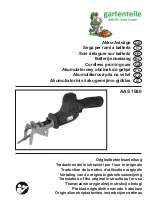
GB
- 28 -
8.1.1 Making longitudinal cuts (Figure 17)
Longitudinal cutting (also known as slitting) is
when you use the saw to cut along the grain of the
wood. Press one edge of the workpiece against
the parallel stop (7) while the
fl
at side lies on the
saw table (1). The guard hood (2) must always be
lowered over the workpiece.
When you make a longitudinal cut, never adopt
a working position that is in line with the cutting
direction.
•
Set the parallel stop (7) in accordance with
the workpiece height and the desired width.
(See 7.3.)
•
Switch on the saw.
•
Place your hands (with fingers closed) flat on
the workpiece and push the workpiece along
the parallel stop (7) and into the blade (4).
•
Guide at the side with your left or right hand
(depending on the position of the parallel
stop) only as far as the front edge of the gu-
ard hood.
•
Always push the workpiece through to the
end of the splitter (5).
•
The offcut piece remains on the saw table
(1) until the blade (4) is back in its position of
rest.
•
Secure long workpieces against falling off
at the end of the cut (e.g. with a roller stand
etc.).
8.1.2. Cutting narrow workpieces (Fig. 18)
Be sure to use a push stick (3) when making
longitudinal cuts in workpieces smaller than 120
mm in width. A push block is supplied with the
saw! Replace a worn or damaged push stick im-
mediately.
8.1.3.Cutting extremely narrow workpieces
(Fig. 19)
•
Be sure to use a push block when making
longitudinal cuts in very narrow workpieces
with a width of 30 mm and less.
•
The low guide face of the parallel stop is best
used in this case.
•
There is no push block supplied with the
saw! (Available from your specialist dealer).
Replace the push block without delay when it
becomes worn.
8.1.4. Making bevel cuts (Fig. 16/20)
Bevel cuts must always be used using the parallel
stop (7).
•
Set the blade (4) to the desired angle. (See
7.5.)
•
Set the parallel stop (7) in accordance with
the workpiece width and height (see 7.3.1)
•
Carry out the cut in accordance with the work-
piece width (see 8.1.1., 8.1.2 and 8.1.3.)
8.1.5. Making cross cuts (Fig. 21)
•
Slide the cross stop (21) into one of the
grooves (21) in the table and adjust to the
required angle. (See 7.4.) If you also want to
tilt the blade (4), use the groove (21) which
prevents your hand and the cross stop from
making contact with the blade guard.
•
Press the workpiece firmly against the cross
stop (14).
•
Switch on the saw.
•
Push the cross stop (14) and the workpiece
toward the blade in order to make the cut.
•
Warning!
Always hold the guided part of the workpiece.
Never hold the part which is to be cut off.
•
Push the cross stop (14) forward until the
workpiece is cut all the way through.
•
Switch off the saw again. Do not remove the
offcut until the blade has stopped rotating.
9. Replacing the power cable
Danger!
If the power cable for this equipment is damaged,
it must be replaced by the manufacturer or its
after-sales service or similarly trained personnel
to avoid danger.
Anl_TC_TS_2025_1_U_2025_1_ECO_SPK9.indb 28
Anl_TC_TS_2025_1_U_2025_1_ECO_SPK9.indb 28
13.04.2018 11:41:56
13.04.2018 11:41:56
















































